In this guide, we cover all of the best practices for email marketing to help your campaigns achieve better results.
Email remains one of the most effective and reliable marketing channels for any business. By following a few email marketing best practices, you’ll be able to achieve just about anything with your email marketing campaigns.
Whether you’re starting your email marketing strategy from scratch, or if you want to optimize your current email marketing efforts, there are a few important tricks and tips to use.
Here are 20 of the most effective email marketing best practices that you should keep in mind before sending out any campaign.
- Segment Your Email List
- Use a Double Opt-In Signup Process
- Keep Your Email List Clean
- Optimize Your Subject Line and Preview Text
- Send a Welcome Email
- Add Value in Your Emails
- Personalize Your Emails
- A/B Test Your Emails
- Make Emails Casual, Conversational, and Easy to Skim
- Focus Your Emails On One Clear CTA
- Never Use a No-Reply Email Address
- Make it Easy to Unsubscribe
- Stick to a Consistent Sending Schedule
- Never Buy Email Lists
- Use Analytics to Improve Your Email Marketing Strategy
- Use an Attractive Email Design
- Consider Using an Email Signature
- Know How to Grow Your Email List
- Test Your Emails Before You Send Them
- Understand the Different Types Of Emails You Can Send
1. Segment Your Email List
Successful email marketing is all about sending the right content to the right people. The best way to achieve this is to segment your email list.
This involves creating different email lists for different leads and customers based on their purchase history, actions they took, demographics, or more.
For example, you could have one list full of first purchase customers, one list of repeat customers, and one list of prospects. Or you could get more in-depth, and create a list of customers who live in different cities, or of different ages or genders.
Whatever the case, doing this lets you send relevant content to each list. This makes your email marketing more personalized, helping you achieve higher engagement levels.
To achieve this, you will need to use an email marketing platform with automation abilities. You can set up a workflow to place people into a list if they perform a certain action (like sign up on a certain page or purchase a particular product). Now you will have segmented lists that you can target with unique content.
This is one of the most useful email marketing best practices to increase your open rates and conversions.

Follow our complete guide to lead segmentation for more information on how to do this.
2. Use a Double Opt-In Signup Process
A double opt-in is when a user has to perform a second action to confirm their email subscription.
First, they sign up for your email list on your signup form. Second, they are sent an email asking them to confirm their signup. Once they have agreed to this email, you can start sending them email marketing content.
Why is this important?
It ensures you have an active list of email subscribers who actually want to receive content from you. It also helps you attract some form of engagement from all new subscribers because they have to confirm their subscription. This is an important step for improving email deliverability.
Take a look at the double opt-in example below:

After signing up for the mailing list, you have to respond to the first email with a simple “Yes”. This means all new subscribers have engaged with the email address, which helps it land directly in their inboxes. It also means all new subscribers are definitely interested in receiving email content.
Doing this might result in a small list of subscribers, but this list will be more actively engaged.
3. Keep Your Email List Clean
One of the most important email marketing best practices to improve deliverability is to make sure your mailing list is only full of real active email addresses.
Each time you send out email marketing campaigns, you will probably experience email bouncebacks. This is to be expected (to a certain extent).
Email bounces could happen if you send emails to an address that doesn’t exist, such as an address with a typo in it or an email address that was deleted. If your email bounces continue and increase, it could affect your email deliverability.
The best strategy here is to remove these emails from your list. Check your email bounces, and remove any emails that consistently bounce. If you get automated responses from your emails because the email address is for a “no-reply” address, a support line, or something similar, then these email addresses aren’t active, so you can remove them too.
Ideally, your email list should only consist of active, real subscribers who want to receive your content. This will improve your email engagement, helping you achieve better results with each email marketing campaign you send.
4. Optimize Your Subject Line and Preview Text
Your email subject line is what determines whether people click on the email or not. If your subject line is not appealing enough, it will lower your open rates.
So, what makes a good subject line? Try to keep it short, simple, and intriguing. Make it clear that the email adds value, and leaves the reader wanting to find out more. Your subscribers should know what the email is about and what benefit it provides when they read the subject line.
You should also optimize your preview text. This is the short snippet of text after the subject line and it’s something that many brands forget about. Essentially, the preview text acts as an extension of your subject line, and you can use it to make your subject lines even more engaging and interesting.
Here’s a great example of how to use your preview text to improve your subject line:

To help you out, here are some proven subject line formulas that you can use to increase your open rate.
5. Send a Welcome Email
You want to engage your email subscribers as soon as they sign up. This is why sending a welcome email is important. Welcome emails have higher engagement rates than any other email that you send. This means they’re the perfect chance to start your email relationship on a strong note.
First of all, a friendly welcome email is just a great way to create a positive connection with your new subscriber. It lets them know who you are and what you’re about. It also helps subscribers recognize your emails, so they won’t be surprised when they see your newsletter next week.
Welcome emails also offer the perfect chance to get your subscribers to take an action. They’re just shown an interest in your brand by signing up, and they will be as engaged as ever. Including a welcome discount coupon, for example, can results in a lot of first-time sales straight away.
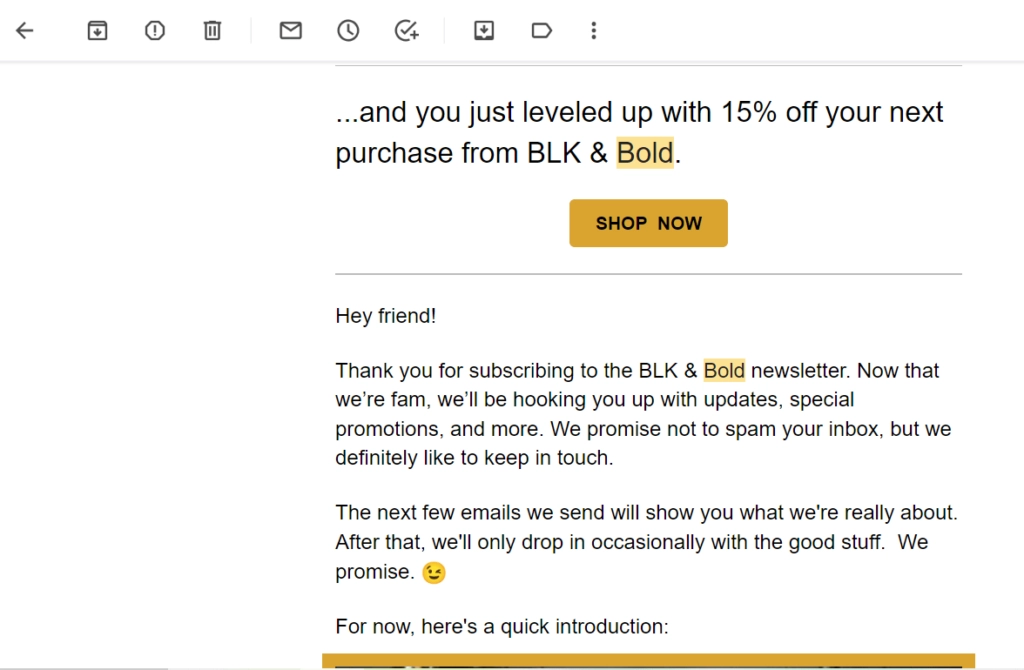
6. Add Value in Your Emails
People get bombarded by marketing emails every day. Your job is to make sure that your emails don’t fall under that same spammy category. You’ll achieve this by adding value.
What does this mean? Try to offer something that benefits your subscribers instead of just trying to sell to them. If you’re only sending out emails about your products and services, then your email list will soon lose interest.
Instead, share helpful content, guides, and anything interesting that addresses your audience’s pain points. This could include blog content, videos, or even special offers and discounts. The bottom line is that your subscribers should benefit from receiving your emails, it shouldn’t just be a way to get something out of them.
Make these benefits clear in both your subject line and email copy.
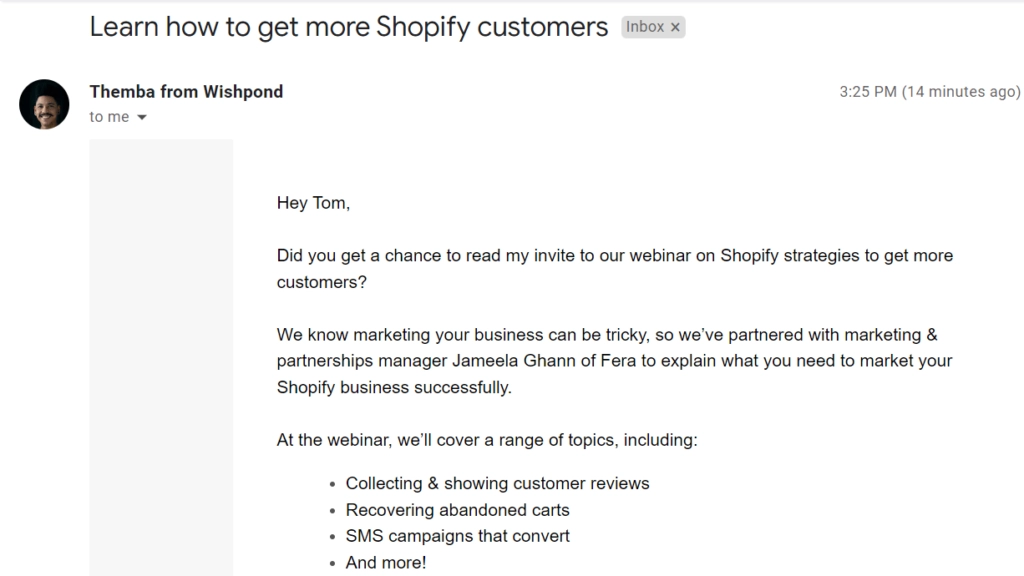
7. Personalize Your Emails
Personalization is one of the most essential email marketing best practices. The idea behind this is to make sure you send content to your subscribers that is relevant to them and that matches their interests. Just because you’re sending out a mass email blast, it doesn’t mean it should feel personal.
The first step toward personalization is to include your recipient’s name. Saying “Hey Tom” instead of “Hey there” is a small detail, but it makes a big difference in how personal the email feels. This makes the recipient feel like the marketing email is directed straight to them.
To take personalization to the next level, try to only send relevant content to the subscriber. For example, if the recipient purchased a product, reach out and ask them how that product is performing, and maybe recommend products that complement it. You could send personalized content based on location, demographics, or more. This ties back to the first point about segmenting your email lists.
8. A/B Test Your Emails
An important email marketing best practice to ensure you’re always optimizing your content is to use A/B testing. This is when you send out two different variations of the same email to two different halves of your email list. You test which variation achieves the best result, and use this for future campaigns.
If you don’t A/B test your emails, then you won’t be able to find ways to improve your emails. A/B testing reveals what your audience likes and what they don’t like, Over time, this can help you achieve far better results.
I’ll share a strategy that we use at Wishpond. We A/B test each individual campaign to ensure we’re always improving.
We start by having two email lists – one is full of our most engaged subscribers, and the other is our least engaged subscribers. We first send an email to the engaged list and A/B test two variations. Then, we send the best results of this to the less engaged list.
This means our least engaged subscribers always get sent the best version of our emails, which can help to re-engage them. And, by sending to our most engaged subscribers first, we get more engagement straight away which can help email deliverability.

9. Make Emails Casual, Conversational, and Easy to Skim
You don’t want to send boring, difficult-to-read emails to your subscribers. Instead, it’s important that your subscribers feel like the emails they receive come from a real person, just like them. This is why using casual, human language is important.
Write your emails in a friendly, conversational way – just as though you were sending them to a friend. You should also aim to keep your emails short, sweet, and to the point.
Try to make them easy to skim. Your subscribers don’t want to spend 10 minutes reading your email. They want to open it up and know what it’s about straight away. So, get straight to the point.
Generally, the more simplified your emails are, the better.
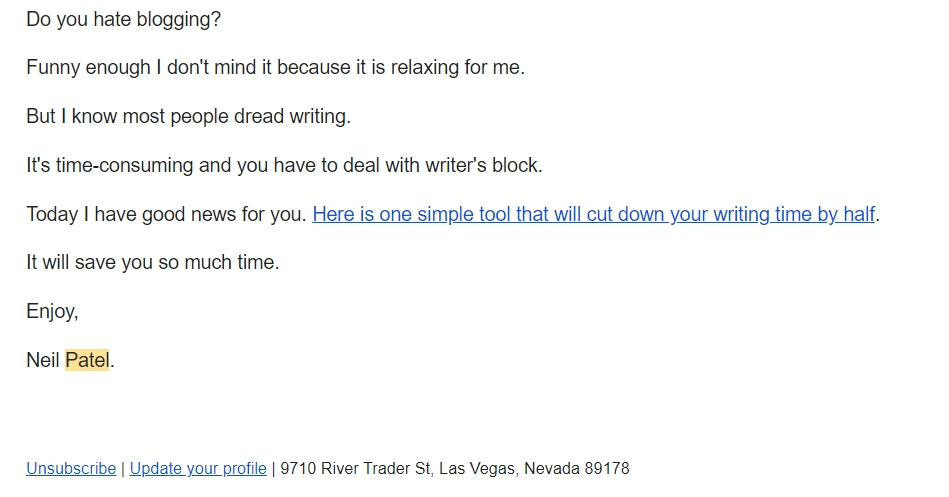
10. Focus Your Emails On One Clear CTA
Every email campaign you send out should have one clear goal. This goal should be explained in the call to action (CTA) at the end of the email.
Never confuse your readers by sending an email with more than one CTA, or an email that tries to achieve various actions. Keep it focused, and zone in on a single, clear goal.
This lets you highlight the value of your email more effectively. It also helps you build a stronger case for the action you want the recipient to take.
And when it comes to your CTA, the words you use make a big difference. Try to highlight value or benefits in your CTA, and make the words actionable and compelling.
For example, instead of saying “book a demo”, you could say “see how we can help you grow your business” or “get a free guided tour”. This adds more value, it’s more interesting and more relatable.
For more inspiration, take a look at these 50 CTA examples.
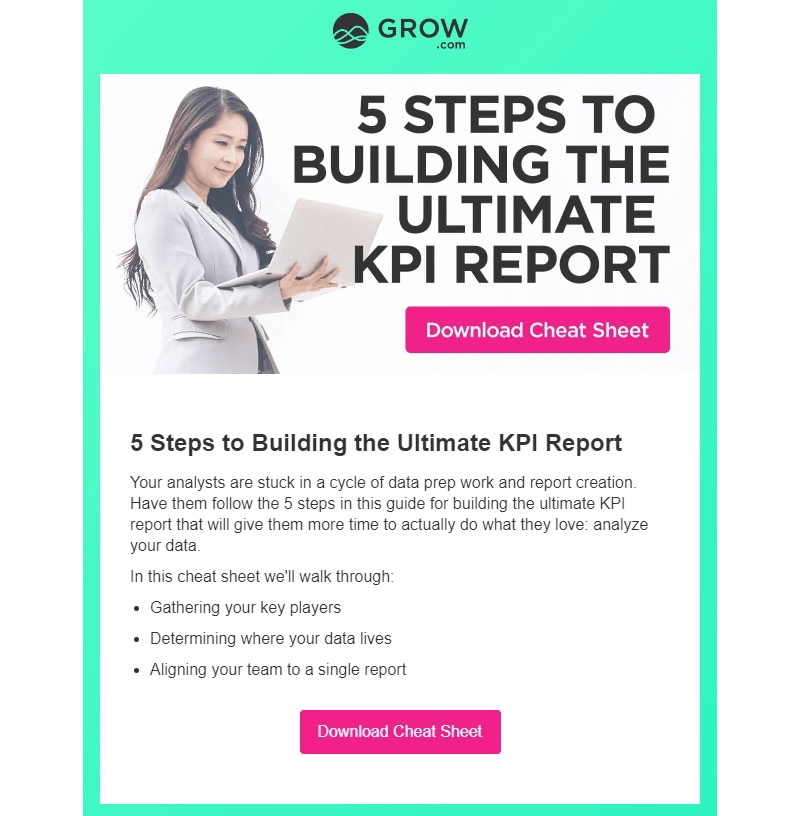
11. Never Use a No-Reply Email Address
Email marketing should not just be a one-way flow of information. You should be engaging with any email subscribers who want to get a hold of you. This is important for your brand, and it’s important for email deliverability.
If subscribers are sending you messages, and you reply, then this is a good sign in terms of deliverability. Basically, it will help you get more emails into inboxes and less into spam.
By marking your emails as “no reply”, you’re basically telling subscribers to ignore you. This could result in a one-way ticket straight to spam folders.
12. Make it Easy to Unsubscribe
You want to have as large of an email list as possible, right? Yes, but more importantly you want to have a highly engaged list.
Having a clearly visible, working unsubscribe button in every email is important. Not only is it a part of the CAN-SPAM Act to include this, but it also helps you maintain a good sender reputation.
If people don’t want to receive emails from you, which is normal, the best thing they can do is simply unsubscribe. They weren’t interested in your emails anyway, so you didn’t really lose out on much. If they have no option to unsubscribe, they will probably block you as a sender or mark you as spam.
This can be a big blow to your sender’s reputation, and result in your emails ending up in many more spam folders.

13. Stick to a Consistent Sending Schedule
Another one of the most essential email marketing best practices is to send your emails consistently. You don’t have to be overly frequent, but it’s important that you maintain a steady cadence. This could be once a day, once a week, once a month, or whatever schedule best suits you.
If you have a sudden change in your sending behavior, it could impact your sender’s reputation and deliverability. Not only this, but it might also confuse your subscribers, which is never a good thing.
The best strategy is to create an email calendar. Outline what days you will send your emails and what the emails will be about. You can use an email marketing tool to schedule these in advance.
Doing this ensures you maintain absolute consistency.
14. Never Buy Email Lists
This should be obvious, but it’s still something we have to emphasize. Never ever pay for your contact list. This will only damage your sender’s reputation.
We won’t get into the technical side behind this, but a bought email list is fake, and email providers will be able to tell. If you buy email lists, you will end up in the spam folder. That’s the main reason.
The second reason is that even if your bought subscribers are real people and they do see your email, they never signed up for your mailing list so they will instantly mark you as spam. They also won’t engage with your content, so what’s the point?
Building an email organically takes a bit of time and effort, but it’s the only solution for effective email marketing.
You can take a look at our guide to the best ways to grow your email marketing list to help you out.
15. Use Analytics to Improve Your Email Marketing Strategy
The great thing about using an email marketing platform is that it will reveal the email marketing metrics you need to know.
To develop a strong email marketing strategy, it’s important to keep an eye on these metrics and optimize your email marketing efforts accordingly. This will help you create emails that engage your audience more and achieve better results.
While there are many email marketing metrics to know, the most important ones are:
- Deliverability: How many emails were successfully sent out and how many failed to send, bounced, or landed in the wrong inbox
- Open rate: How many people opened your emails compared to how many people were sent your emails. This is determined by your subject line and whether the email lands in your subscriber’s inbox and not their spam folder.
- Click through rate: How many people opened your email and clicked on the link in your email. This depends on your email copy and CTA.
- Unsubscribes: How many people unsubscribed from your email marketing list after receiving your email.
Monitoring these metrics is important for understanding where your strategy is falling short, where you’re doing well, and what needs to change. It’s important to understand what elements of your emails affect which metrics so that you know what to improve.
To learn more about this, follow our complete breakdown of email marketing KPIs you need to follow.
16. Use an Attractive Email Design
Successful marketing emails don’t need to just read well, they also need to look good! It’s important to pay attention to the design and layout of your email and ensure that this matches the goal of your campaign.
Using a header image is generally a good idea, as long as it adds value and makes sense for your campaign. You could also include a footer image, as well as images and videos within the email. Just be aware that the more media elements you add, the longer your email will take to load. This can have a negative effect on your deliverability.
One good strategy is to A/B test tour designs. Send one email with nothing but text, and another with images. See which email your audience responded better to.
It’s also important that you use an email marketing platform that includes easy, professional templates. With a platform like Wishpond, you can choose between a range of expertly designed email templates to help your campaign look the part.

17. Consider Using an Email Signature
Although not an essential email marketing best practice, using an email signature can help you achieve better results with each email you send out.
First, an email footer gives your audience a person to relate to. You can include your name, your headshot, and your contact details. This makes your email marketing more transparent.
An email signature also allows you to include your logo and branding, helping you to spread more brand awareness.
Finally, you can also include an extra CTA in your signatures, such as links to your social media pages or an important piece of content. Just make sure this doesn’t detract from your main marketing message.
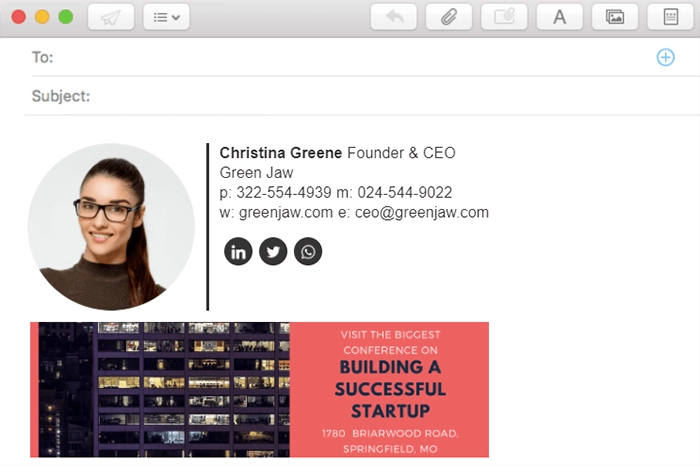
18. Know How to Grow Your Email List
Successful email marketing starts by having a large, engaged email list. It’s important to consider how to get email subscribers as part of your email marketing strategy.
You don’t necessarily need a massive email list. What’s important is that your subscribers are interested in your brand and your email content. To achieve this, you’ll need to attract email subscribers with offers that appeal to them.
This could include lead magnets that are relevant to your brand (like ebooks), running a giveaway of your products, or offering new email subscribers discounts. This way, everyone who signs up for your list is interested in what you offer. This is essential for email marketing to be a success.

For more information on this, check out our guide on how to grow your email list.
19. Test Your Emails Before You Send Them
The last thing you want is to send out an email with a broken link or an obvious typo. Trust us, it’s a lot easier to do this than you might think.
Before hitting send, send out a test email to yourself. Any good email marketing software, like Wishpond, should have this feature. This lets you preview how your email looks in your inbox, how it reads, how fast it loads, and how everything works.
Better yet, send a test email to one of your colleagues or friends and ask them for their advice.
20. Understand the Different Types of Emails You Can Send
You can achieve just about anything with email marketing. As long as you have a clear goal for your campaign, you can set this up to get awesome results for your business.
Many businesses get lost with their email marketing strategy, and might not be too sure about what kind of emails to send. If you think you’re sending too much of the same thing, or not doing enough, then you might need to diversity your emails a bit.
Ome important types of emails, beyond your regular newsletter, include:
- Winback emails: To try to re-engage subscribers or customers who have not interacted with your brand in a long time
- Abandoned cart campaigns: used by eCommerce stores, these emails are sent out to shoppers who abandon their carts. These emails generally include a special offer to get the shopper to come back and complete their purchase.
- Welcome emails: To say hello to your new subscriber and introduce your brand
- Automated drip campaigns: An automated series of emails that send out to subscribers after they perform certain actions
These are just a few of the types of marketing emails you can send. Take a look at our complete guide to email marketing examples for more ideas.
What are the 5 T’s of Email Marketing?
While we’ve just covered 20 powerful email marketing best practices, you can slim this list down by simply remembering the five T’s of email marketing. They are:
- Tease: Entice your audience and grab their attention
- Target: Make your email content specific to your targeted audience
- Teach: Educate and share interesting content
- Test: Test out your email content and see what performs best
- Track: Monitor the right analytics to understand your email performance
These 5 T’s apply to your content marketing plan in general. If you can’t remember all of these best practices, simply try to remember these five Ts. get them right, and all of your essential email marketing bases will be covered!
Conclusion
There you go, 20 of the most effective email marketing best practice to remember. The important thing about any email marketing strategy is that you’re always optimizing and improving it to achieve better results. By following these tactics, you’ll be able to improve your email deliverability, engagement, and overall results.
So, to recap, the most important email marketing best practices are:
- Segment Your Email List
- Use a Double Opt-In Signup Process
- Keep Your Email List Clean
- Optimize Your Subject Line and Preview Text
- Send a Welcome Email
- Add Value in Your Emails
- Personalize Your Emails
- A/B Test Your Emails
- Make Emails Casual, Conversational, and Easy to Skim
- Focus Your Emails On One Clear CTA
- Never Use a No-Reply Email Address
- Make it Easy to Unsubscribe
- Stick to a Consistent Sending Schedule
- Never Buy Email Lists
- Use Analytics to Improve Your Email Marketing Strategy
- Use an Attractive Email Design
- Consider Using an Email Signature
- Know How to Grow Your Email List
- Test Your Emails Before You Send Them
- Understand the Different Types Of Emails You Can Send
Follow these steps and email could very well become your most important, and rewarding marketing channel. If you want to learn more about email marketing, take a look at some of our resources below:
Related Content
- Best Email Marketing Examples: 20 Types of Emails You Can Send
- 11 Email Marketing KPIs and Metrics You Should Be Tracking
- What is an Email Blast? How to Send Email Blasts (With Templates)
- 4 Shockingly Good Email Marketing Examples for Ecommerce Brands
- 11 Email Marketing KPIs and Metrics You Should Be Tracking

